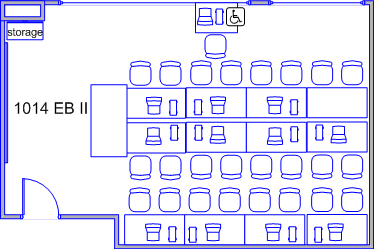Difference between revisions of "Teaching Labs/1014 EB2"
| Line 1: | Line 1: | ||
| − | __NOTOC__ | + | {{Teaching Labs}}__NOTOC__ |
The '''Computer Organization and Logic Lab''' is used by the ECE 206, Introduction to Computer Organization, classes. The class itself introduces students to the key ideas of effieciently organizing a computer, not only the hardware but the software as well. The lab will reinforce these concepts by giving students exposure to basic computer software and hardware. Microprocessor design, switching circuits, and direct memory access are some of the hardware concepts students will work with, while logic access, assembly language programming, and number representation are some of the software ideas students will deal with. ECE 206 students will also familiarize themselves with the LC3 and Cygwin, both unique to this class and lab. | The '''Computer Organization and Logic Lab''' is used by the ECE 206, Introduction to Computer Organization, classes. The class itself introduces students to the key ideas of effieciently organizing a computer, not only the hardware but the software as well. The lab will reinforce these concepts by giving students exposure to basic computer software and hardware. Microprocessor design, switching circuits, and direct memory access are some of the hardware concepts students will work with, while logic access, assembly language programming, and number representation are some of the software ideas students will deal with. ECE 206 students will also familiarize themselves with the LC3 and Cygwin, both unique to this class and lab. | ||
Revision as of 12:45, 27 February 2006
The Computer Organization and Logic Lab is used by the ECE 206, Introduction to Computer Organization, classes. The class itself introduces students to the key ideas of effieciently organizing a computer, not only the hardware but the software as well. The lab will reinforce these concepts by giving students exposure to basic computer software and hardware. Microprocessor design, switching circuits, and direct memory access are some of the hardware concepts students will work with, while logic access, assembly language programming, and number representation are some of the software ideas students will deal with. ECE 206 students will also familiarize themselves with the LC3 and Cygwin, both unique to this class and lab.
Lab Schedule
The schedule is subject to change at anytime, so check back often. To schedule this lab, email ecehelp@ncsu.edu.
Equipment
| Model: | Dell Dimension 4400 |
| Processor: | Pentium 4 1.7 GHz |
| RAM: | 512 MB |
| Operating System: | Microsoft Windows XP Professional |
| Number of Computers: | 12 |
| Software: | Symantec Antivirus 10 Wolfcall 1.2.1/AFS/Kerberos PDF Factory Pro 2.40 Microsoft Office 2003 SP2 Microsoft Logoff Screensaver Acrobat Reader 7.0.3 X-win32 6.1.1/PuTTy 0.55 Ultimate Zip 2.7.1 TecPlot 10 Project 2003 SP2 Visio 2003 SP2 GhostScript/GhostView 8.51 JDK 1.5.0.4 Macromedia Flash Player 8.0.22.0 Macromedia Shockwave Player 10.1.0.11 Quicktime Player 6.5.2 RealPlayer 10.5 WinSCP 3.71 Matlab 7.1 Condor Client (Run Only) 6.6.10 LC3 Cygwin (gcc, gdb) Visual Slickedit 9.0 |
